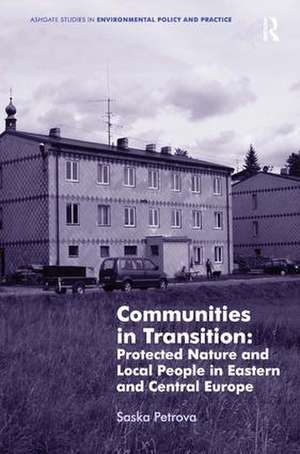Communities in Transition: Protected Nature and Local People in Eastern and Central Europe
Autor Saska Petrovaen Limba Engleză Hardback – 18 iun 2014
| Toate formatele și edițiile | Preț | Express |
|---|---|---|
| Paperback (1) | 469.34 lei 6-8 săpt. | |
| Taylor & Francis – 2 sep 2016 | 469.34 lei 6-8 săpt. | |
| Hardback (1) | 1055.21 lei 6-8 săpt. | |
| Taylor & Francis – 18 iun 2014 | 1055.21 lei 6-8 săpt. |
Preț: 1055.21 lei
Preț vechi: 1286.84 lei
-18% Nou
Puncte Express: 1583
Preț estimativ în valută:
201.92€ • 211.25$ • 167.73£
201.92€ • 211.25$ • 167.73£
Carte tipărită la comandă
Livrare economică 02-16 aprilie
Preluare comenzi: 021 569.72.76
Specificații
ISBN-13: 9781409448501
ISBN-10: 1409448509
Pagini: 206
Dimensiuni: 156 x 234 x 13 mm
Greutate: 0.47 kg
Ediția:1
Editura: Taylor & Francis
Colecția Routledge
Locul publicării:Oxford, United Kingdom
ISBN-10: 1409448509
Pagini: 206
Dimensiuni: 156 x 234 x 13 mm
Greutate: 0.47 kg
Ediția:1
Editura: Taylor & Francis
Colecția Routledge
Locul publicării:Oxford, United Kingdom
Notă biografică
Dr Saska Petrova is a Lecturer in Geography, at the School of Environment, Education and Development at The University of Manchester, UK.
Recenzii
'Central and Eastern Europe now assumes an important place in international nature conservation practice but figures rarely in scholarship. This book makes a significant contribution towards filling this gap by moving from a review of global conservation practice to insightful case studies of co-management in the Czech Republic and Macedonia.' Thomas Sikor, University of East Anglia, UK
Cuprins
Chapter 1 Introduction; Chapter 2 From Place Attachment to Wilderness; Chapter 3 Protected Areas and National Parks at the Global Scale; Chapter 4 Obstacles, Victims and Opportunists; Chapter 5 Nature Protection and Municipal Government During Socialism and After; Chapter 6 From Inflexible Legislation to Flexible Governance; Chapter 7Šumava; Chapter 8 Conclusions;
Descriere
Providing an integrated perspective on why, how and for whom nature conservation practices have been implemented in CEE, this book sheds further light upon the mechanisms through which such practices both redefine and are affected by the everyday life of people living in national parks. Offering a critical global review of the environmental motivations and power interests behind the creation of national parks, as well as a typology of the relations between local people and the dynamics of nature protection in them, this work challenges the dichotomy between developed and developing countries that pervades much of the academic literature on nature protection.
